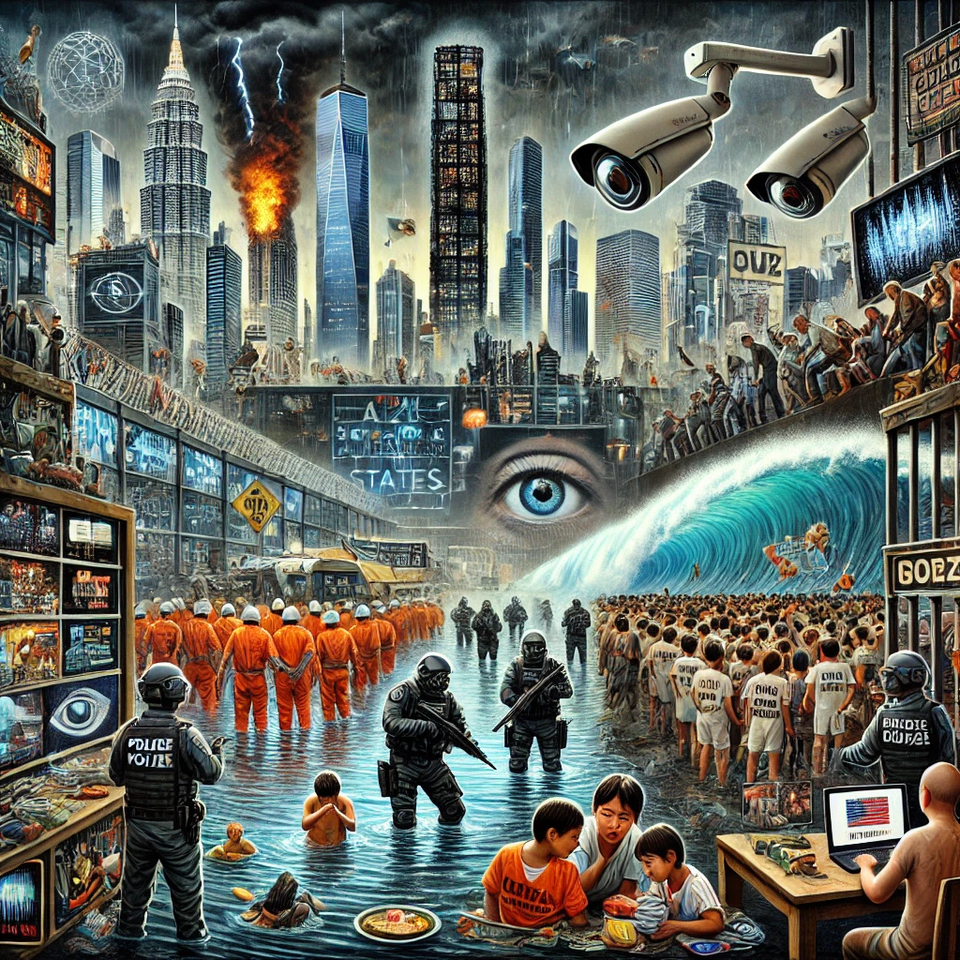Dystopian Events 2024

Around the world, 2024 saw a surge of authoritarian measures, with governments tightening control at the expense of human rights. In many countries, leaders used the pretext of security or tradition to stifle opposition and restrict freedoms, prompting widespread criticism:
• Afghanistan’s Gender Apartheid: The Taliban regime intensified its repression of women and girls. In late 2024, they banned women from attending medical school, closing one of the last avenues for female education . This edict, compounding earlier bans on secondary and university education, will leave Afghanistan with no new female doctors or nurses. As male doctors are often forbidden from treating women, the policy is effectively condemning women to “unnecessary pain, misery, sickness, and death” due to lack of care . The move drew condemnation from the UN and human rights groups as an outrageous assault on women’s rights.
• Crackdown in Hong Kong: In the largest national security trial since China’s takeover, 45 pro-democracy activists in Hong Kong were sentenced to 4 to 10 years in prison for organizing an unofficial primary election . The mass sentencing under the Beijing-imposed National Security Law – which treats peaceful political organizing as “subversion” – was decried by Western governments as a “politically motivated” persecution of dissent . Once a vibrant city, Hong Kong’s civil society has been muzzled, with dozens of journalists, lawmakers, and activists jailed or in exile.
• Mass Detentions in El Salvador: President Nayib Bukele’s “state of exception” anti-gang campaign – while popular domestically for reducing crime – took on dystopian extremes. By 2024, over 81,000 people had been rounded up in mass arrests, including more than 3,000 children, some as young as 12 . Detainees are held in mega-prisons in inhumane conditions, with little food or medical care, and at least 261 prisoners have died in custody . Human rights reports note instances of torture and coerced confessions of minors, and convictions for vague offenses like “unlawful association” based on scant evidence . While Bukele won re-election amid the crackdown, observers call it an authoritarian campaign that “amounts to collective punishment” and flouts basic legal standards .
• Global Authoritarian Drift: Numerous other examples underscored a broader trend of democratic backsliding. Russia continued jailing opposition figures and silencing independent media under wartime censorship laws, while intensifying propaganda to prop up its war in Ukraine. In Iran, morality police resurged to enforce strict hijab laws, and protesters faced harsh crackdowns and prison sentences after the 2022 women-led uprising. Uganda enacted one of the world’s most draconian anti-LGBTQ laws – including the death penalty for “aggravated homosexuality” – which drew international outrage and sanctions threats . Even some democracies saw overreach: for example, several U.S. states passed sweeping bans on abortion with almost no exceptions, leading to real scenarios of women in medical crisis being denied care. Five women in Texas, for instance, sued after being forced to endure life-threatening pregnancy complications without therapeutic abortions, a dire consequence of laws ostensibly meant to “preserve life” . Across the globe, authoritarian leaders often justified these policies with rhetoric of fear and misinformation, leveraging social divides to entrench their rule . The result has been a palpable erosion of civil liberties – a world inching closer to the “dark times” forewarned by rights organizations .
Technological Surveillance and AI Concerns
Technological advances in 2024 brought powerful new capabilities – and new methods of surveillance and control that many find dystopian. From omnipresent cameras to artificial intelligence, technology is being wielded in ways that erode privacy, manipulate truth, and even raise existential fears:
• AI-Powered Mass Surveillance: Governments are increasingly deploying artificial intelligence to monitor and police populations. Around 56 countries have been identified using AI surveillance systems to keep cities “safe,” often with scant oversight . These range from smart camera networks with facial recognition to cellphone monitoring. In China and other authoritarian states, such systems create a digital dragnet – automatically tracking individuals, flagging “pre-crimes,” and discouraging dissent. Studies show that simply the presence of AI surveillance causes people to protest less, as citizens fear being identified and punished . Even democratic governments edged into this territory. In London, police vastly expanded use of live facial recognition, scanning hundreds of thousands of faces on city streets and making over 500 arrests in 2024 using this technology . Officials tout crime prevention, but civil liberty groups in Britain warn of a slippery slope toward a high-tech Big Brother. The spread of these “digital eyes” has experts warning that, without restraints, AI-driven policing will become a tool of oppression, letting states exercise control with less visible brutality .
• Pervasive Tracking and Data Exploitation: The year saw ongoing revelations about spyware and digital tracking. Notorious spyware like Pegasus (made by Israel’s NSO Group) continued to spark alarm as more cases emerged of its use against journalists and dissidents worldwide. In one instance, WhatsApp reported dozens of users – including activists – were targeted by Pegasus, raising fears even democracies might be deploying such cyberweapons . Location data, social media activity, and even DNA databases are being vacuumed up by authorities and corporations. Critics say we are living through the formation of a “surveillance society” where citizens’ every move is recorded. Corporations too have joined in: reports revealed some employers using AI to micromanage workers – for example, e-commerce warehouses tracking workers’ productivity second-by-second and firing those who fall behind. Internal documents from a 2024 investigation described these as “new, dystopian methods to exploit and punish employees” via constant electronic surveillance . Privacy advocates warn that without new protections, ubiquitous surveillance will normalize a world akin to 1984, with algorithmic oversight replacing personal freedom.
• Disinformation and Deepfakes: The rise of generative AI has supercharged the ability to distort reality. In 2024 – a major election year in many countries – officials warned that AI-driven deepfake videos, images, and voices could flood information channels. The World Economic Forum declared early in the year that “misinformation and disinformation is the most severe short-term risk the world faces”, noting that AI is amplifying manipulated information that could destabilize societies . Indeed, doctored videos of politicians went viral on social media, and “bot armies” of AI-generated profiles churned out propaganda posts. Observers feared a “misinformation apocalypse” where citizens can no longer trust their eyes or ears. From a fake audio clip of a world leader declaring war to bogus images of disasters, AI made it trivial to fabricate news, eroding the baseline of shared truth. This has a profoundly dystopian implication: a populace that cannot discern reality is easier for bad actors to control.
• AI Out of Control? Even as AI became more embedded in daily life – writing our emails, driving cars, automating industries – prominent experts sounded alarms that advanced AI itself could spiral beyond human control. In a remarkable moment, hundreds of top AI scientists and tech CEOs issued a public statement warning that AI poses a risk of human extinction if mismanaged . They urged global policymakers to treat AI risks with the same gravity as nuclear war and pandemics. Concerns range from autonomous weapons and lethal drones powered by AI, to super-intelligent systems that could act in unintended, harmful ways. While these scenarios remain theoretical, the fact that leading AI labs themselves voiced such existential fears was unsettling to many. It underscored how quickly AI capabilities are advancing, outpacing governance. Ethicists noted more immediate issues too – AI systems inheriting biases and making discriminatory decisions (in policing, hiring, lending), effectively “algorithmizing” social inequalities. The rapid deployment of AI without proper checks in 2024 left society grappling with a classic sci-fi question turned real: Are we building technologies that we can no longer control, and will they undermine human agency and dignity?
Climate Disasters and Environmental Collapse
Aerial view of downtown Porto Alegre, Brazil submerged by floodwaters in May 2024. Catastrophic floods inundated 90% of Rio Grande do Sul state, displacing over half a million people .
The year 2024 delivered one climate cataclysm after another, reinforcing fears that environmental collapse is no longer a distant scenario but an unfolding reality. From record heat waves to biblical floods, events that once might have been called “apocalyptic” became all too common:
• Hottest Year on Record: Global temperatures surged to a new high in 2024, shattering all past records. It was the first time Earth’s average temperature for a full year exceeded the critical 1.5°C warming threshold above pre-industrial levels . Scientists warned this trend could be a tipping point – if the planet remains above 1.5°C for long, we face escalating “death, destruction, species loss and sea level rise” from extreme weather . The heat was not abstract: it fueled deadly heatwaves on every inhabited continent. Southern Europe endured a “Cerberus” heatwave with temperatures topping 45°C, sparking wildfires in Greece and Italy. In the Middle East, some cities saw heat indexes over 60°C, nearly at the limit of human survival. UN Secretary-General António Guterres lamented that “the last 10 years are the top 10 hottest on record” and declared “this is climate breakdown – in real time” . Far from slowing down, warming is accelerating – 2024’s temperature jump was so sharp that it temporarily pushed the climate into territory scientists have desperately tried to avoid .
• Mega Disasters on All Continents: The year’s catalogue of natural disasters was staggering in scale. At least 11,500 people were killed by extreme weather in 2024, and 148 million were directly affected . Highly anomalous events struck everywhere: In Derna, Libya, an entire city was partially destroyed in September when intense rainfall (made worse by climate change) burst dams, killing over 4,000. In Hawaii, a ferocious wildfire fanned by drought and hurricane winds leveled the town of Lahaina in August, a tragedy reminiscent of Blade Runner-orange skies that had also choked the U.S. Northeast during Canada’s unprecedented wildfires in June. Catastrophic floods inundated countries north and south – from Italy’s Emilia-Romagna and Slovenia in Europe, to Brazil, where torrential rains in May submerged town after town. In Brazil’s Rio Grande do Sul, 90% of the state was flooded and over 500,000 people displaced in what officials called the worst flooding in 85 years . Conversely, parts of Africa suffered exceptional drought: across southern Africa, some 25 million people faced food shortages as crops withered . Supercharged storms lashed the Western Pacific; an “extraordinary” typhoon season in East Asia brought record rains to Japan and China . In the United States, the toll was especially high – the country was hit by 27 separate billion-dollar weather disasters in 2024, from hurricanes to wildfires, the most ever recorded in a single year . Images of devastation – flattened homes, towns turned to muddy lakes, and refugees of climate disasters – gave the world an uneasy feeling that this is the new normal.
• Ecosystems at the Brink: Beyond immediate disasters, the natural world showed alarming signs of systemic collapse. The world’s oceans, which absorbed much of the excess heat, reached the highest temperatures ever observed, leading to mass coral bleaching. The Great Barrier Reef in Australia suffered its fifth mass bleaching since 2016, with scientists declaring a “catastrophic” die-off in 2024 – in some areas, nearly 40% of corals died from heat stress and subsequent disease . This loss of reef ecosystems foreshadows extinctions and fisheries collapse. In the Amazon, severe drought late in the year dried up rivers to record lows , stranding communities and river transport. The Amazon rainforest – a crucial carbon sink – in parts began emitting more CO₂ than it absorbs, edging toward a feared tipping point where it could turn into savannah. Polar extremes also raised alarm: Antarctica’s sea ice hit the lowest extent ever recorded, disrupting marine life and potentially destabilizing ice shelves. These developments added to fears that climate “tipping points” (such as ice sheet collapse or ocean current shifts) are being reached faster than anticipated. Climate scientists overwhelmingly agree we are not on track to meet the Paris Agreement goals; a 2024 survey of top scientists found almost 80% expect at least 2.5°C of warming – a level of heating described as “catastrophic” for humanity’s future . In short, the dystopian climate future long predicted by researchers began manifesting in real time: “climate collapse” is no longer abstract, but visible in drowned cities, burning forests, and the silent die-off of species.
• Inadequate Response and Denial: Equally unsettling was the faltering political response to these crises. At the COP28 climate summit, held at the end of 2024, global leaders were faced with the stark failure of current policies to rein in emissions. Yet the conference itself became a dystopian spectacle: it was chaired by an oil executive, UAE’s Sultan al-Jaber, who sparked outrage by claiming “there is no science indicating we need to phase out fossil fuels” – a statement blatantly at odds with the consensus of climate experts . This came as fossil fuel companies enjoyed windfall profits from sustained high oil and gas prices. The disconnect between scientific urgency and political action was glaring. Protesters – from Pacific Island youth to European climate strikers – took to the streets to demand a rapid transition off fossil fuels, some adopting slogans like “1.5° is dead”. The frustration was encapsulated by UN climate chief Simon Stiell’s warning that continuing on the current path is “setting fire to our only home”. The climate events of 2024 thus felt profoundly dystopian not just for their destructive power, but because societies seemed unable or unwilling to change course, even as the evidence of an accelerating catastrophe mounted.
Economic Inequality and Corporate Exploitation
Economic trends in 2024 painted a picture of growing inequality and brazen corporate greed that critics likened to a cyberpunk dystopia – a world where billionaires thrive in luxury high-rises while ordinary people struggle to survive in the alleyways below. Key developments highlighted an ever-widening chasm between the ultra-rich and everyone else, along with troubling exploitation in the labor force:
• Wealth Gap at Record Levels: The rich got astronomically richer in 2024, even as many countries faced cost-of-living crises. A report by Oxfam revealed that billionaire wealth grew by $2 trillion in 2024 alone – an average of $5.7 billion per day – which is three times faster than it grew even in 2023 . By the end of the year, the world’s billionaires as a group were worth more than ever, and wealth is concentrating further: Oxfam predicts the planet will see its first trillionaires (people worth over $1,000 billion) within a decade, and not just one but at least five trillionaires at the current pace . Meanwhile, global poverty rates barely budged despite economic recovery – essentially, the benefits of growth are being captured almost entirely by the top 1% . Much of this wealth accumulation, the report notes, is unearned – about 60% of billionaire fortunes now come from inheritance, monopolistic practices, or political connections rather than innovation or productive investment . This unprecedented concentration of wealth and power in the hands of a few has been widely denounced as “feudal” or “colonial” in nature , with the ultra-rich exerting outsized influence over economies and even politics. The CEO of Oxfam International warned that we are witnessing “survival of the richest”, where the lack of serious wealth taxes or redistributive policies allows multi-billionaires to effectively exist in a separate, gilded world apart from society’s struggles.
• “Greedflation” and Soaring Corporate Profits: As ordinary consumers battled rising prices for food, housing, and energy, evidence mounted that corporate profiteering was a major driver of inflation. In the U.S. and Europe, 2024 research showed that many companies took advantage of global crises (pandemic disruptions, war in Ukraine) to jack up prices well beyond cost increases, resulting in record profit margins. By mid-2024, economists calculated that roughly one-third to one-half of recent inflation could be attributed to businesses widening their markups – a phenomenon dubbed “greedflation” . For example, food conglomerates and energy firms posted all-time high profits while household grocery and utility bills soared. This sparked public outrage: lawmakers in the US and EU accused Big Oil, Big Pharma, and others of “price gouging” and called for windfall taxes. Senator Elizabeth Warren pointed out that companies were boasting on earnings calls about their pricing power, essentially admitting to fleecing consumers. Yet, in many cases, executives and investors reaped the rewards unchecked – reinforcing a sense that the economy is rigged to favor the top. The dystopian contrast of 2024 was stark: corporate CEOs enjoyed multi-million-dollar paydays and shareholders saw booming returns, while workers’ real wages barely kept up with inflation, and countless families had to choose between essentials under financial strain.
• Worker Exploitation and Labor Backlash: Alongside inequality, 2024 exposed numerous instances of corporations treating workers as disposable – sometimes literally like machines or slaves – prompting a wave of anger and activism. Major companies were caught in scandals involving abusive labor practices. For instance, it came to light that hundreds of migrant children were working illegally in U.S. factories (making products for brands from cereal to car parts), often in dangerous conditions reminiscent of the 19th century. Advocacy groups reported that child labor in the U.S. had risen to levels “not seen in decades,” and rather than stamp it out, some states passed laws to roll back child labor protections, effectively legalizing teens in hazardous jobs . This prompted comparisons to Oliver Twist-style exploitation. Globally, supply chains remained rife with forced labor – from garment sweatshops to cobalt mines for tech gadgets – drawing criticism that Western consumerism is built on hidden human suffering. Even high-tech industries saw exploitation: in February, Amazon.com was ordered to pay restitution to workers in Saudi Arabia after an investigation found contractors had subjected migrant workers to conditions “amounting to human trafficking” in Amazon warehouses . Whistleblowers described employees toiling 12-hour days in sweltering facilities, their passports confiscated – a scenario one might expect in a dystopian novel about corporate rule.
Workers themselves fought back in 2024 with an uptick in labor strikes and unionization efforts, suggesting the exploited class pushing against corporate overlords. In the United States, the Hollywood writers’ and actors’ strikes (which stretched into 2024) won concessions from studios on pay and limits to AI usage – the studios had wanted to use AI to replicate actors’ likenesses, a proposal actors called existentially dystopian for their profession. The United Auto Workers launched a strike against the Big Three automakers, spotlighting how auto executives’ salaries and profits were soaring even as assembly-line workers struggled; the eventual deal included record wage gains. These battles highlighted a common theme: corporations had been maximizing profits by squeezing workers (through wage suppression, union-busting, and automation), until workers reached a breaking point. The dystopia for many laborers in 2024 was an all-too-real one of precarious gig jobs, warehouse drudgery under AI surveillance, and even revived child labor – but the year also showed growing resistance to these conditions.
• Corporate Influence and Corruption: Another worrying trend was the outsized influence of mega-corporations on public policy and the commons. Observers pointed out that industries from Big Tech to Big Oil often behave like shadow governments unto themselves. In 2024, lobbying by fossil fuel companies was credited with watering down climate action in legislatures, even as climate disasters mounted. Tech giants continued to gobble up competitors, extending near-monopoly control over information flows – a scenario that resembles a corporate oligarchy more than a free market. Perhaps the most egregious example was the pharmaceutical industry’s control over medicine pricing: despite a new Alzheimer’s drug in 2024 that cost over $26,000 per patient, Medicare was initially barred from negotiating the price due to industry-written laws. Meanwhile, corruption scandals emerged, such as bribery and money laundering charges against corporate executives and officials in various countries (e.g., a major global retail furniture company was implicated in spying on employees and customers). All of this fueled public distrust. Polls showed a majority of young people believe capitalism is failing and favor heavier regulation of corporations. Without corrective action, analysts warn, we risk solidifying a neo-feudal economy where wealth and power are concentrated at the top – essentially a real-life corporate dystopia.
Social and Cultural Developments Evoking Dystopia
Beyond hard politics and economics, 2024 witnessed social and cultural shifts that many found deeply unsettling – as if elements of classic dystopian fiction were bleeding into everyday life. These include aggressive censorship of ideas, polarization and hate, and the fraying of social cohesion:
• Book Bans and Censorship: In scenes alarmingly reminiscent of Fahrenheit 451, schools and libraries in parts of the United States saw unprecedented levels of book banning. Educators and free speech advocates sounded the alarm as over 10,000 book titles were banned in U.S. public schools during the 2023–2024 school year, tripling the number from the year before . Many classrooms in states like Florida and Texas were left with empty shelves as new laws required removing any book not officially vetted for “appropriateness.” The banned books disproportionately included works about race, LGBTQ+ themes, and even classic literature . For example, books addressing racism (like Toni Morrison’s novels), or simply featuring gay characters or discussing sexual health, were pulled from curricula and libraries. Some teachers reported covering up classroom libraries with paper or locking away entire collections. This “education purging” has been widely criticized as ideologically driven censorship, aiming to whitewash history and diversity. PEN America called the multi-state barrage of book bans “unprecedented in scope” and warned that students are being denied access to knowledge and literature at a scale not seen in modern memory . The images of rows of barren bookshelves and lists of forbidden books in 2024 felt ripped from a dystopian storyline – a democracy sliding toward thought control by restricting reading.
• Attacks on Marginalized Groups: Social policies took a dark turn in several places, targeting minority communities in ways that human rights observers likened to “othering” campaigns. Apart from the anti-LGBT laws such as Uganda’s mentioned above, certain U.S. states enacted or enforced laws against transgender individuals – for instance, banning gender-affirming care for trans youth (and even some adults) and barring transgender students from sports and bathrooms. To the LGBTQ+ community, 2024 often felt like living in a hostile dystopia where their very existence was being legislated out. Concurrently, reproductive rights were severely curtailed in large swathes of America due to 2022’s Roe v. Wade reversal, and 2024 brought the tangible consequences: women with non-viable pregnancies forced to endure sepsis or pain because doctors feared legal repercussions for performing an abortion. These real stories – of patients nearly dying while lawyers had to approve lifesaving care – struck many as nightmarish and medieval, a Handmaid’s Tale made real. Moreover, refugees and migrants continued to be treated harshly. In the U.S., images of families held in detention camps or southern border walls being raised higher underscored an ethos of exclusion. Europe saw anti-immigrant politics gain ground too, with some governments pushing asylum-seekers into remote camps or outsourcing border enforcement in ways criticized as inhumane. The common thread was a surge in policies that dehumanize certain groups – whether due to religion, ethnicity, gender, or sexuality – harkening back to the darkest chapters of the 20th century.
• Misinformation and Polarization: Society’s shared reality further fractured in 2024, as misinformation continued to spread, often unchecked. Conspiracy theories remained deeply embedded in public discourse. In the US, a significant portion of one political party still embraced the false belief that the 2020 election was stolen, and candidates in the 2024 election trafficked in those claims – essentially denying objective truth to large audiences. Online, echo chambers and algorithm-driven feeds meant people lived in parallel information universes. One person’s news feed might be full of AI-fabricated “evidence” of a cabal controlling the world, while another’s contains genuine reporting – leading to completely divergent worldviews. The result has been families and communities torn apart by ideological radicalization, much like the “Two Minutes Hate” in Orwell’s 1984, where factual debate is impossible. This polarization has at times exploded into real-world violence – from politically motivated attacks to an alarming rise in hate crimes. In 2024, monitors noted surges in antisemitic and anti-Muslim incidents, especially amid conflicts like the Israel–Gaza war. Rallies and protests often devolved into vitriol, with social media amplifying the most extreme voices. Many commentators described the atmosphere as “Orwellian,” not only due to misinformation but also blatant attempts by officials to rewrite history or deny facts. For instance, when confronted with images of empty school libraries from the book bans, some authorities claimed it was a hoax even as teachers insisted it was true. This gaslighting – being told not to trust one’s own eyes – is quintessentially dystopian, undermining the concept of truth.
• Public Space and Protest Under Pressure: The way societies handled protest and expression in 2024 also evoked dystopian vibes. In some democratic countries, authorities responded to civil unrest with tactics that civil rights groups warned were authoritarian in nature. For example, in France, mass protests against a pension reform were met with heavy police force, tear gas, and thousands of arrests, leading the UN to question France’s excessive use of force. In the US and UK, late 2023 and 2024 saw crackdowns on pro-Palestinian demonstrations – from attempts to ban marches to intimidating surveillance of protesters. Privacy International reported incidents like police in Canada using high-powered cameras to monitor student protesters from afar . Such measures contribute to a climate of fear around civic engagement. When people fear that attending a peaceful protest might land them on a watchlist or cost them their job (as some experienced after online shaming campaigns), that is a serious chill on free expression. Additionally, the ubiquity of cameras and the knowledge that one’s face might be run through a facial recognition system at a protest can dissuade lawful democratic participation . This encroachment on the right to dissent is what one would expect in a surveillance state dystopia.
• Cultural Erosion and Anxiety: Culturally, there was a pervasive sense of anxiety about the future – a feeling that the social fabric is tearing. The youth of 2024 reported high rates of climate anxiety, depression, and a feeling of powerlessness. The epidemic of mass shootings in the United States continued unabated – by the end of the year, the country once again suffered hundreds of mass shooting incidents, to the point where lockdown drills and daily news of gun violence have become normalized. Living in constant fear of gun violence has been described as “dystopian reality” by American schoolchildren who have never known a time without active shooter drills. On another front, technology infiltrated culture in eerie ways: the rise of immersive deepfake pornography (often non-consensual, using women’s images), the addictive grip of algorithmic TikTok feeds, and the debut of early brain-computer interfaces all raised ethical questions about human autonomy. By 2024, even our leisure had a dystopian tint – consider the popularity of the Metaverse and VR worlds, where people escape a depressing reality for a virtual one, echoing science fiction like Ready Player One.
In sum, the social/cultural landscape saw a battle between forces of control and division versus those of openness and community. Many of the disturbing trends – censoring books, demonizing minorities, living under constant surveillance, and fraying trust in truth – are hallmarks of dystopian literature. Yet they were very real in 2024. The public outcry against these developments has been loud, with protests, court challenges, and grassroots movements pushing back. Whether society can reverse these trends is an open question, but recognizing them is the first step. As we leave 2024, it’s clear that the world faces not just one but multiple dystopian challenges simultaneously – political authoritarianism, technological overreach, environmental collapse, economic oligarchy, and cultural fragmentation. Each of these alone is alarming; together, they present a stark warning that the “dystopian future” is no longer fictional, but here and now unless concerted action is taken to course-correct.
Sources:
• Human Rights Watch – World Report 2025: Dark times in 2024 (global crackdown overview)
• Reuters – Hong Kong activists jailed under security law ; Uganda anti-LGBTQ law (2023)
• Human Rights Watch – Taliban ban women’s medical training
• The Guardian – El Salvador detains thousands of children in gang crackdown
• AP News / AJC – Earth hits hottest year, passes climate threshold
• Mongabay – 2024 extreme weather impacts
• PEN America / SLJ – Record school book bans in 2023-24
• Economic Policy Institute – Corporate profits and inflation (“greedflation”)
• Oxfam International – Inequality report 2024 (“Takers Not Makers”)
• Bulletin of Atomic Scientists – AI surveillance and democracy
• World Economic Forum via Knight Institute – Disinformation as top global risk, AI amplifying it
• Wikipedia (via sources) – Rio Grande do Sul floods 2024 statistics and Great Barrier Reef bleaching .






Member discussion